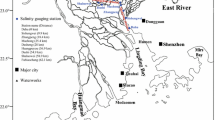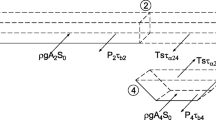Abstract
Despite many previous investigations, there is no theoretically justifiable equation to determine the freshwater discharge, tidal velocity, and salinity in a complex estuary that contains several branches. In this study, the longitudinal distributions of freshwater and salinity concentration in multi-branched estuaries are investigated using a mathematical model, considering the energy balance by frictional head loss and the salt balance by diffusion and advection in a one-dimensional steady-state condition. We attempt to obtain the time-mean freshwater discharge rate quantitatively at a junction where the main flow separates into two branches. The salinity distribution along each branch is calculated by following the dispersion coefficient equation previously proposed for a single estuary. The salinity field is divided into the near-coast region and the upstream region, because in each segment the inland velocity varies according to the tidal flux. For computing the tidal velocity, we propose the Burgers equation and the Hoph-Cole transformation. The theoretical results obtained by these equations were found to be in good agreement with a set of observed data in the Red River estuary system.








Similar content being viewed by others
References
Abbott MB, Ionescu F (1967) On the numerical computation of nearly-horizontal flows. J Hydraul Res 5:97–117
Austin JA (2004) Estimation of effective longitudinal dispersion in the Chesapeake Bay. Estuar Coast Shelf Sci 60:359–368
Azevedo IC, Bordalo AA, Duarte PM (2010) Influence of river discharge patterns on the hydrodynamics and potential contaminant dispersion in the Douro estuary (Portugal). Water Res 44:3133–3146
Benton ER, Platzman GW (1972) A table of solutions of the one-Dimensional Burgers equation. Q Appl Math 30:195–212
Burgers JM (1948) A mathermatical model illustrating the theory of turbulence. Adv Appl Mech 1:171–199
Cat VM, Duong BD (2006) Assessment of saline water intrusion into estuaries of Red-Thai Binh River during dry season having considered water released from upper reservoirs and tidal fluctuation. Proceeding of the Vietnam-Japan Estuary Workshop, Hanoi, Vietnam
Cole JD (1951) On a quasi-linear parabolic equation occurring in aerodynamics. Q Appl Math 9:225–236
DHI (2011) A Modelling System for Rivers and Channels Reference Manual. http://www.hydroeurope.org/jahia/webdav/site/hydroeurope/shared/Teams-2011/team1/Manuals/Mike_11_ref.pdf
Duc NH, Umeyama M (2011) Saline intrusion due to the accelerative sea level in the Red River system in Vietnam. ASCE Conference Proceeding, Palm Spring, USA, 4413–4422, doi:10.1061/41173(414)459
Duc NH, Shintani T, Umeyama M (2010) Influence of saline intrusion during the dry season in Red river and Thai Binh river systems, Vietnam. ISEH Conference Proceeding, Athens, Greece, 317–327
Dyer KR (1997) Estuaries: a physical introduction, 2nd edn. Wiley, Chichester, p 195
Eaton TT (2007) Analytical estimates of hydraulic parameters for urbanized estuary – Flusing Bay. J Hydrol 347:188–196
Garvine R, McCarthy R, Wong KC (1992) The axial salinity distribution in the Delaware estuary and its weak response to river discharge. Estuar Coast Shelf Sci 35:157–165
Gay PS, O’Donnell J (2009) Buffering of the salinity intrusion in estuaries by channel convergence. Hydrol Earth Syst Sci Discuss 6:6007–6033
Graas S, Savenije HHG (2008) Salt intrusion in the Pungue estuary, Mozambique: effect of sand banks as a natural temporary salt intrusion barrier. Hydrol Earth Syst Sci Discuss 5:2523–2542
Graf WH, Altinakar MS (1991) Hydrodynamique. Eyrolles, Paris
Gurram SK, Karki KS, Hager WH (1997) Subcritical junction flow. J Hydraul Eng 123(5):447–455
Hoph E (1950) The partial differential equation u t + uu x = μu xx . Commun Pure Appl Math 3:201–230
Hsu CC, Wu FS, Lee WJ (1998) Flow at 90 degree equal-width open-channel junction. ASCE J Hydraul Eng 124(2):186–191
IMHE (2009) Forecasting of tidal propagation and salinity intrusion in the Red River Delta. Technical Report, Vietnam Institute of Hydrology, Meteorology, and Environment, 183 pp
Ippen AT (1966) Estuary and Coastline hydrodynamics. McGraw-Hill, New York, 744 pp
Kesserwani G, Ghostine R, Vazquez J, Mose R, Abdallah M, Ghenaim A (2008) Simulation of subcritical flow at open-channel junction. Adv Water Resour 31:287–297
Kimmerer WJ (2002) Physical, biological, and management responses to variable freshwater flow into the San Francisco Estuary. Estuaries 25(6B):1275–1290
Lewis RE, Uncles RJ (2003) Factors affecting longitudinal dispersion in estuaries of different scale. Ocean Dyn 53:197–207
Longley WL (1994) Freshwater inflows to Texas bays and estuaries: ecological relationships and methods for determination of needs. Texas Water Development Board, Austin
Maren DSV, Hoekstra P (2004) Seasonal variation of hydrodynamics and sediment dynamics in a shallow subtropical estuary: the Ba Lat River, Vietnam. Estuar Coast Shelf Sci 60:529–540
Monismith SG, Kimmerer W, Stacey MT, Burau JR (2002) Structure and flow-induced variability of the subtidal salinity field in Northern San Francisco Bay. J Phys Oceanogr 32:3003–3019
Nguyen AD, Savenije HHG, Pham DN, Tang TT (2008) Using salt intrusion measurements to determine the freshwater discharge distribution over the branches of a multi-channel estuary: The Mekong Delta case. Estuar Coast Shelf Sci 77:433–445
Nguyen DH, Shintani T, Umeyama M (2010) Influence of saline intrusion during the dry season in Red river and Thai Binh river systems, Vietnam. ISEH Conference proceeding, Athens, Greece, 317–327
Nguyen DH, Umeyama M, Shintani T (2012) Importance of geometric characteristics for salinity distribution in convergent estuaries. J Hydrol 448–449:1–13
Paulson RW (1970) Variation of the longitudinal dispersion coefficient in the Delaware River Estuary as a function of freshwater inflow. Water Resour Res 6:516–526
Prandle D (2003) Relationships between tidal dynamics and bathymetry in strongly convergent Estuaries. J Phys Oceanogr 33:2738–2750
Savenije HHG (2005) Salinity and tides in alluvial estuaries. Elsevier, Amsterdam, 197 pp
Shabayek S, Steffler P, Hicks F (2002) Dynamic model for subcritical combining flows in channel junctions. J Hydraul Eng 128(9):821–828
Shaha DC, Cho YK (2009) Comparison of empirical models with intensively observed data for prediction of salt intrusion in the Sumjin River estuary, Korea. Hydrol Earth Syst Sci 13:923–933
Shaha DC, Cho YK, Kwak MT, Kundu SR, Jung KT (2011) Spatial variation of the longitudinal dispersion coefficient in an estuary. Hydrol Earth Syst Sci 15:3679–3688
Silberman E et al (1963) Friction factors in open channels. J Hydraul Div ASCE 89(2):97–143
Sklar FH, Brơwder JA (1998) Coastal environmental impacts brought about by alterations to freshwater flow in the Gulf of Mexico. Environ Manag 22:547–562
Skreslet S (1986) The role of freshwater outflow in coastal marine ecosystems, NATO ASI Series, Gth edn. Springer, Berlin
Slinger JH, Taljaard S, Largier JL (1994) Changes in estuarine water quality in response to a freshwater flow event. In: Orth RJ, Dyer KR (eds) Changes in fluxes in estuaries. Implications from science to management. Olsen & Olsen, Fredensborg, pp 51–56
U.S. Army Corps of Engineers (2010). HEC-RAS: hydraulic reference manual, Ver. 4.1, http://www.hec.usace.army.mil/software/hec-ras/documentation/HEC-RAS_4.1_Reference_Manual.pdf
Van den Burgh P (1972) Ontwikkeling van een methode voor het voorspellen van zoutverdelingen in estuaria, kanalen en zeeen. Rijkwaterstaat Rapport, 10–72 (in Dutch)
Wright LD, Coleman JM, Thom BG (1973) Process of channel development in a high tide range environment: Cambridge Gulf-Ord river delta, Western Australia. J Geol 81:15–41
Zhang E, Savenije HHG, Wu H, Kong Y, Zhu J (2011) Analytical solution for salt intrusion in the Yangtze Estuary, China. Estuar Coast Shelf Sci 91:492–501
Acknowledgements
The writers gratefully acknowledge the members of the Institute of Meteorology, Hydrology, and Environment (IMHE), Hanoi, Vietnam for their kindly supports during the data collection.
Author information
Authors and Affiliations
Corresponding author
Rights and permissions
About this article
Cite this article
Umeyama, M., Nguyen, D.H., Vu Minh, C. et al. A Comprehensive Approach for Estimating Hydraulic Quantities in a Multi-branched Estuarine System. Water Resour Manage 28, 3937–3955 (2014). https://doi.org/10.1007/s11269-014-0719-7
Received:
Accepted:
Published:
Issue Date:
DOI: https://doi.org/10.1007/s11269-014-0719-7




